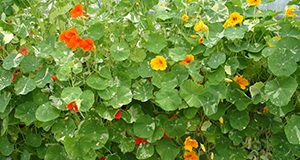Abstract
Edible flowers can be a fresh addition to main dishes, side dishes, desserts, and drinks. Their value stems from their visual appeal, taste, nutritional content, and medicinal properties. This 7-page document examines the production and distribution of edible flowers in Florida. Written by Caroline de Favari Tardivo and Geoffrey Meru and published by the UF/IFAS Horticultural Sciences Department, August 2018.
http://edis.ifas.ufl.edu/hs1321
References
Arya, V., D. Kumar, and M. Gautam. 2014. "Phytopharmacological review on flowers: Source of inspiration for drug discovery." Biomedicine & Preventive Nutr. 4: 45-51. https://doi.org/10.1016/j.bionut.2013.08.009
Badertscher, K. B., and S. E. Newman. 1996. Flowers. Ext. Bul. 7-237. Colorado State Univ.
Barash, C. W. 1993. Edible flowers: From garden to palate. Golden, Colo.: Fulcrum Publ.
Barash, C. W. 1998a. "The flavors of flowers." The Herb. Companion 10: 32-37.
Barash, C. W. 1998b. "Please eat the flowers." Hort. 95: 36-40.
Belsinger, S. 1991. Flowers in the kitchen: A bouquet of tasty recipes. Loveland, Colo.: Interweave Press.
Bradley, L. 2014. "Choosing and using edible flowers." https://gardening.ces.ncsu.edu/2014/10/choosing-and-using-edible-flowers/
Bradshaw, A. 2018. "Edible flowers list with edible flower names and pictures." https://commonsensehome.com/edible-flowers/
Breyer, M. 2017. "42 flowers you can eat." https://www.treehugger.com/green-food/42-flowers-you-can-eat.html
Cichewicz, R. H., K. C. Lim, J. H. McKerrow, and M. G. Nair. 2004. "Kwanzoquinones A-G and other constituents of Hemerocallis fulva 'Kwanzo' roots and their activity against the human pathogenic trematode Schistosoma mansoni." Tetrahedron. 58: 8597-8606. https://doi.org/10.1016/S0040-4020(02)00802-5
Doyle, M. P., and M. C. Erickson. 2008. "Summer meeting 2007 - the problems with fresh produce: an overview." J. Appl. Microbiol. 105: 317-330. https://doi.org/10.1111/j.1365-2672.2008.03746.x
Hochmuth, R., and D. Cantliffe. 1990. Alternative Greenhouse Crops-Florida Greenhouse Vegetable Production Handbook, Vol 3. HS791. Gainesville: University of Florida Institute of Food and Agricultural Sciences. http://edis.ifas.ufl.edu/cv272.
LeBlanc, D.I., R. Stark, B. MacNeil, B. Goguen, C. Beraulieu. 1996. "Perishable food temperature in retail stores." New Development in Refrigeration for Food Safety and Quality Intl. Inst. Refrigeration Commission. 6: 42-57.
Kelley, K. M., A. C. Cameron, J. A. Biernbaum, and K. L. Poff. 2003. "Effect of storage temperature on the quality of edible flowers." Postharvest Biol. and Technol. 27: 341-344. https://doi.org/10.1016/S0925-5214(02)00096-0
McVicar, J. 1992. Good enough to eat: Growing and cooking edible flowers. London: Kyle Cathie.
Mlcek J., and O. Rop. 2011. "Fresh edible flowers of ornamental plants - a new source of neutraceutical foods." Trends in Food Sci. & Technol. 22: 561-569. https://doi.org/10.1016/j.tifs.2011.04.006
Petrova, I., N. Petkova, and I. Ivanov. 2016. "Five edible flowers-Valuable source of antioxidants in human nutrition." Intl. J. of Pharmacognosy and Phytochemical Res. 8: 604-610.
Ratnasooriya, W. D., S. A. Deraniyagala, S. D. N. K. Bathige, C. L. Goonasekara, and J. R. A. C. Jayakody. 2005. "Antinociceptive action of aqueous extract of the leaves of Ixora coccinea." Acta Biologica Hungarica. 56: 21-34. https://doi.org/10.1556/ABiol.56.2005.1-2.3
Rusnak, J. 1999. "Edible flowers, fresh herbs, baby vegetables: still room for growth." Produce Business. 15: 33-37.
Sandborn, D. 2015. "Edible flowers: Adding color, flavor and fun to your dinner plate." http://msue.anr.msu.edu/news/edible_flowers_adding_color_flavor_and_fun_to_your_dinner_plate
Ukiya, M., T. Akihisa, H. Tokuda, H. Suzuki., T. Mukainaka, E. Ichiishi, and H. Nishino. 2002. "Constituents of compositae plants: III. Anti-tumor promoting effects and cytotoxic activity against human cancer cell lines of triterpene diols and triols from edible chrysanthemum flowers." Cancer Lett. 177: 7-12. https://doi.org/10.1016/S0304-3835(01)00769-8
Wetzel, Kaedra., J. Lee, C. S. Lee, and M. Binkley. "Comparison of microbial diversity of edible flowers and basil grown with organic versus conventional methods." Canadian J. of Microbiol. 11: 943-951. https://doi.org/10.1139/W10-082
Whitman, A. T. 1991. "Edible flowers and culinary herbs: new uses for traditional crops, new crops for traditional growers." Grower Talks. 54: 22-33.
Wongwattanasathien, O., K. Kangsadalampai, and L. Tongyonk. 2010. "Antimutagenicity of some flowers grown in Thailand." Food and Chem. Toxicology. 48: 1045-1051. https://doi.org/10.1016/j.fct.2010.01.018
Unless otherwise specified, articles published in the EDIS journal after January 1, 2024 are licensed under a Creative Commons Attribution-NonCommercial-NoDerivs 4.0 International (CC BY-NC-ND 4.0) license.

